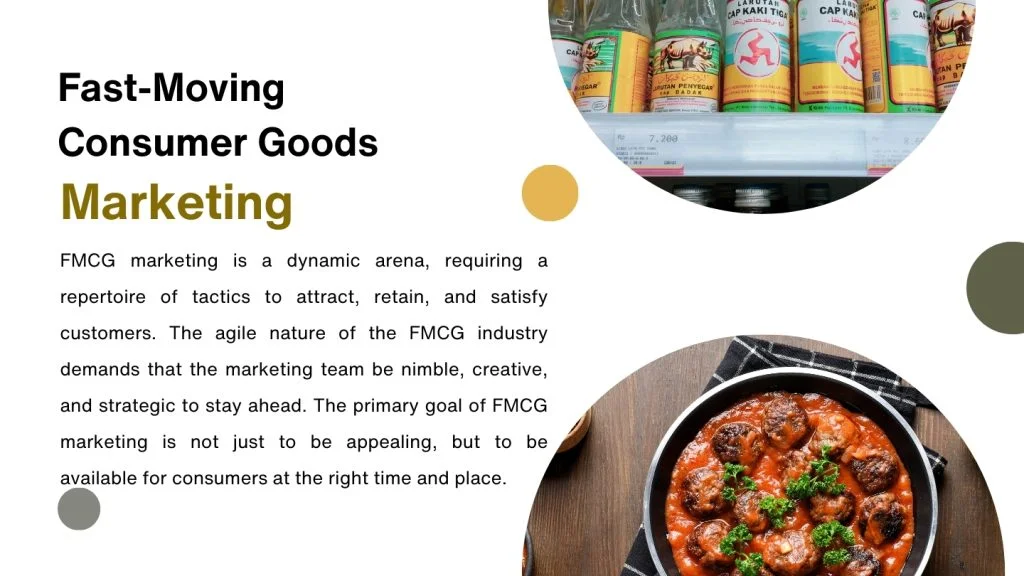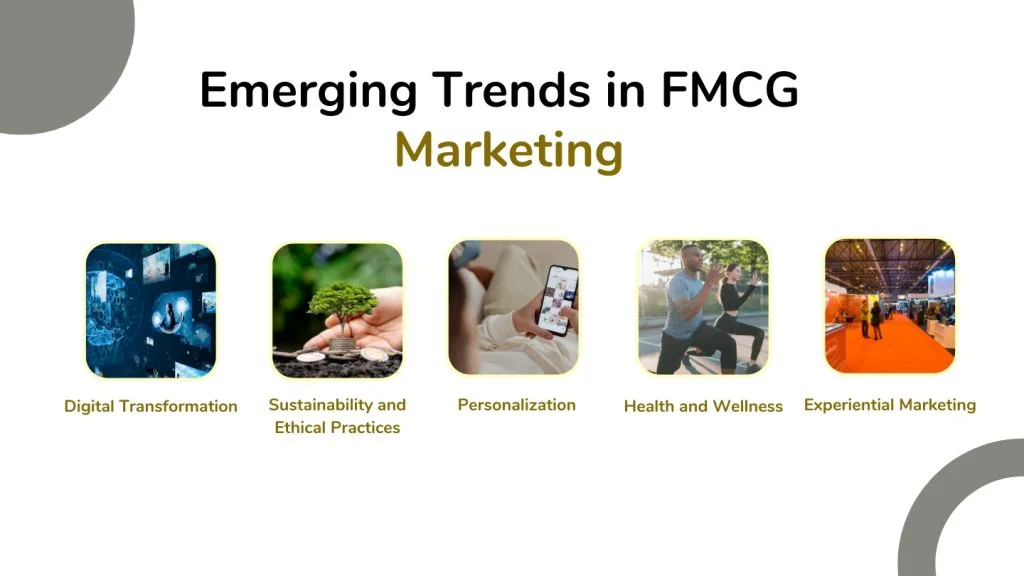Fast-Moving Consumer Goods are low-cost and fast-selling products. These include food products, beverages, toiletries, and other consumable goods. FMCG is a highly competitive market, and companies need strong marketing strategies to thrive in such a market. This post will delve into core strategies, emerging trends, and future outlooks on FMCG marketing.
Introduction to FMCG Marketing

FMCG marketing is a dynamic arena, requiring a repertoire of tactics to attract, retain, and satisfy customers. The agile nature of the FMCG industry demands that the marketing team be nimble, creative, and strategic to stay ahead. The primary goal of FMCG marketing is not just to be appealing, but to be available for consumers at the right time and place.
ALSO READ ABOUT 6 Most Effective Digital Marketing Strategies for 2024.
Core Strategies in FMCG Marketing

1. Brand Positioning
Brand positioning is establishing an exclusive place for your brand and its products in the consumer’s mind. It involves showcasing unique selling points that separate your brand and make it more trustworthy. For FMCG products, these selling points can be the quality, pricing, convenience, or a new or unique feature. Strong and widespread marketing can foster a good brand reputation and enhance customer loyalty.
2. Product Innovation
Staying updated and relevant to new changes and innovation is the key to maintaining a strong position in the FMCG market. It entails new product development, improving and innovating existing ones, and responding to changing consumer needs. Innovation can range from adding a new flavor packet and packing to catering to a new consumer base that is more concerned with emerging health and lifestyle trends.
3. Effective Distribution
An efficient distribution system entails making the products available to consumers when and where they need them. This involves strengthening your supply chain, working with retailers, and optimizing logistics. FMCG marketers usually use a combination of both direct and indirect distribution channels to increase their reach.
4. Pricing Strategy
Pricing is a crucial element of FMCG Marketing. Businesses must find the perfect balance between profitability and competitive prices to become popular consumer choices. Popular pricing strategies include a marketing penetration and a premium strategy.
The penetration strategy is a pricing strategy that involves setting the prices of products lower than the market level to attract customers at the start of the business. This strategy aims to gain market share quickly. On the other hand, the premium strategy involves providing high-quality products at a higher price to highlight the brand’s exclusivity and quality. This strategy is often used by established brands with a loyal customer base.
5. Promotional Activities
Promotional activities include several tactics used by the companies to increase product visibility and sales. These tactics include advertising, sales promotions, digital marketing, and public relations. An effective FMCG marketing strategy can create awareness, generate interest, and drive consumer action.
Emerging Trends in FMCG Marketing
The Fast-Moving Goods (FMCG) market is an evolving marketing driven by technological changes, consumer behavior, and market dynamics. Here are the latest trends shaping the FMCG market:

1. Digital Transformation
Digital channels have become an imperative for FMCG companies. Social media, e-commerce, and mobile applications have opened up new, more engaging avenues to gather consumer data and personalize marketing efforts. Companies are investing in various tools that help to enhance customer experience and streamline operations, underlining the urgency of digital transformation in FMCG marketing.
2. Sustainability and Ethical Practices
Consumers are increasingly conscious of the environmental and social impact of their purchases. FMCG companies are responding to this phenomenon by adopting eco-friendly and sustainable practices. These practices include transparency, sustainable packaging, and supporting sustainable causes. Businesses highlight these efforts to enhance brand reputation and be more appealing to socially responsible consumers.
3. Personalization
Personalization includes tailoring marketing efforts to individual consumer preferences. This can be achieved through data analytics, which helps understand consumer behavior and predict trends. Personalizing enhances the consumer experience and makes it more engaging. Personalized marketing is a powerful tool to improve customer satisfaction and loyalty by making consumers feel valued and understood.
4. Health and Wellness
The growing demand for more healthy products has led to more production of healthier FMCG products. Companies are focusing on more health-conscious practices like making products with natural ingredients, reduced sugar, and functional benefits. FMCG marketing strategies have adapted to highlight these healthy attributes to attract more health-conscious consumers.
5. Experiential Marketing
Experiential marketing is the process of creating a memorable and interactive experience for the user, aka consumers. This strategy involves live product demonstrations, in-store events, and interactive online content. By engaging consumers on an emotional level, marketers can strengthen the brand connection.
ALSO READ ABOUT Top 5 Upcoming Trends in Marketing in 2024.
Future Outlook of FMCG Marketing
The future of FMCG marketing will be shaped by the same factors as now, which are technological development, changing consumer behavior, and market dynamics. Here are some predictions for the future of FMCG Marketing:

1. Increased Use of Artificial Intelligence
Artificial intelligence has evolved several markets and has the potential to revolutionize FMCG marketing. Using chatbots, virtual assistants, and predictive modeling, AI can enhance several aspects of marketing. For example, AI can help optimize pricing strategies, create personalized marketing messages, and even improve supply chain efficiency.
2. Greater Focus on Omnichannel Strategies
Omnichannel marketing involves using various online and offline marketing channels to provide a seamless consumer experience. FMCG companies will focus on strengthening omnichannel strategies to ensure strong communication. This ensures that every product is accessible across multiple channels, including physical stores, e-commerce websites, and social media platforms.
3. Enhanced Customer Engagement
Future marketing strategies will prioritize more ways to engage customers. Marketers will use social media platforms to engage more consumers, create interactive content, and use customer feedback to improve products and services. It is essential to have a good relationship with your consumer for long-term success.
4. Adapting to Changing Consumer Preferences.
As consumer preferences evolve, FMCG companies are bound to change and adapt their strategies to meet consumer needs. Companies must monitor market trends, conduct consumer research, and adapt products and marketing strategies accordingly to stay agile and responsive to changing market needs.
5. Sustainability as a Core Strategy
Sustainability is bound to become the most essential part of FMCG marketing in the future. Companies that show their commitment to sustainability will likely attract more consumers and have stronger brand loyalty. Sustainability does not just refer to environmental practices; it also includes healthy business practices and CSR.
ALSO READ ABOUT The Most Important 5 Stages of Consumer Buying Process.
FAQs
What does FMCG stand for?
FMCG stands for Fast-Moving Consumer Goods. These include products such as food, beverages, toiletries, and over-the-counter goods that are used and sold daily.
What are the three major segments of the FMCG industry?
The three major segments of the FMCG industry include beauty products, food and drinks, and household products used on a daily basis.
What are some emerging trends in FMCG marketing?
Here is the list of a few major emerging trends in FMCG marketing:
1. Digital Transformation
2. Sustainability and Ethical Practices
3. Personalization
4. Focus on Health and Wellness
5. Experiential Marketing
Final Statement
FMCG marketing is a fast-evolving and dynamic field. To thrive in this vast and competitive field, you need to understand various marketing aspects, such as consumer behavior, market trends, and effective marketing strategies. FMCG companies can succeed in a highly competitive market by focusing on core strategies such as brand positioning, product innovation, effective distribution, pricing, and promotion.
Emerging trends such as digital transformation, sustainability, personalization, health and wellness, and experiential marketing are reshaping the FMCG landscape. Looking ahead, advancements in AI, adopting omnichannel strategies, enhanced customer engagement, adaptation to changing preferences, and a strong focus on sustainability will drive the future of FMCG marketing.
I hope this article on FMCG Marketing is informative! Let us know in the comment section if you have any questions or suggestions.

